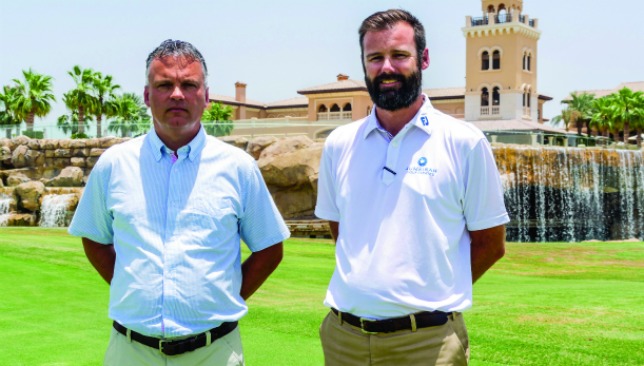
It ensures that same effect is felt by players, spectators and the millions watching on TV.
While a golf course designer may get all the accolades, it really is the agronomy and maintenance teams that are the lifeblood of any golf course. Even the most iconic holes will look desolate and uninspiring if not for the continuous intervention of these guys. They are the ultimate unsung heroes of golf.
One man who has made a name for himself despite trying his best to stay away from the spotlight is Graeme MacNiven, the ‘grass man of the European Tour’. For more than 20 years now, the Deputy Director of Agronomy has been ensuring that Tour events are played on golf courses that measure up to the exacting standards of professional golfers and look good on TV.
The 50-year-old Scotsman is currently on a three-week tour of the UAE, during which he will be inspecting and consulting the agronomy teams of Abu Dhabi Golf Club (which hosts the Abu Dhabi HSBC Golf Championship), Jumeirah Golf Estates (DP World Tour Championship), Emirates Golf Club (Omega Dubai Desert Classic), Sharjah Golf and Shooting Club (which will host
the Sharjah Senior Golf Masters in 2017) and Al Hamra Golf Club (Ras Al Khaimah 2016 Golf Challenge on the Challenge Tour).
VIDEO: @ADGolfChamps Day Four Analysis with @tombushelluae & @TheJoyofGolf #ADGolfChamps https://t.co/ujigjnqg68 pic.twitter.com/flPc4wutaf
— Sport360° (@Sport360) January 24, 2016
“My job with the Tour is to support the venues that are holding the tournaments. I liaise with each greenkeeper to give him as much assistance in how to present and prepare his golf course for a Tour event as I can,” said MacNiven.
“I have got wide experience of events in different golf courses in the world. Guys like Mark (Tupling, Agronomy Manager at JGE), Craig (Haldane, EGC) and Andrew (Whittaker, ADGC) know exactly what needs to be done in their golf course.
What you see during tournaments is a sum total of our expertise and their team’s hard work. The whole result is greater than the sum of its part.
“So, for example, the DP World Tour Championship is played in November. But I came here during the Desert Classic in February, I have come now, and I will come for another visit in September.
“The nature of our job is such that we become, as I call it, ‘snowblind’.
ANALYSIS: @TheJoyofGolf's verdict on @McIlroyRory's @DPWTC and #RacetoDubai winning success https://t.co/aOZFv9A0Oy pic.twitter.com/qwGoiFrGgw
— Sport360° (@Sport360) November 22, 2015
You look at the same thing every day, the problems then appear to be normal. When someone comes in with a fresh pair of eyes, we tend to see things differently.
“Also, the players are always asking us how are things going at this golf course, has anything been changed. The worst thing for the Tour would be to say we don’t know.
We need to have a finger on the pulse all the time. For the professionals, the condition of the golf course is of paramount importance.”
The professionals can be difficult to please at times, but there are certain basic things about a golf course that most of them would like to have.
“I think if you ask different professionals, they will have a different priority list of what they want at a host venue. But it basically boils down to three things – quality of playing surface, uniformity and decent practice facilities,” MacNiven added.
VIDEO: @Danny_Willett reaction to @OmegaDDC #ODDC title win @EmiratesGC https://t.co/wAa14PPhrd pic.twitter.com/xpCwhnvrg4
— Sport360° (@Sport360) February 7, 2016
“You need to give them good quality of playing surface. In order of priority, I’d say you start with the quality of greens, followed by the quality of fairways and then comes the teeing areas.
“Uniformity of playing surface is very important for them. They’d like the 18 greens to be the same speed as the practice green.
They’d like the texture and quality of sand to be similar in all the bunkers.
“And a good practice facility is obviously very important for them.
The length and width of the driving range and the state of the practice green is very important to them.”